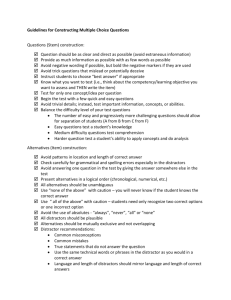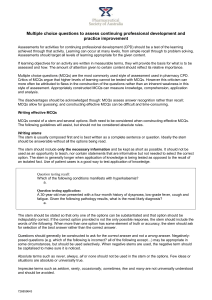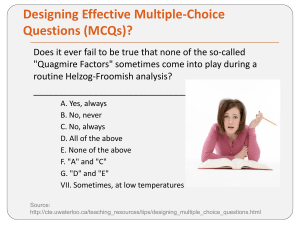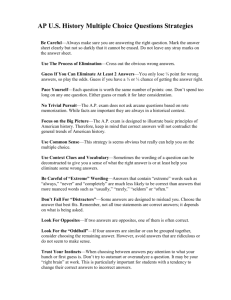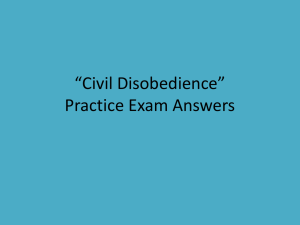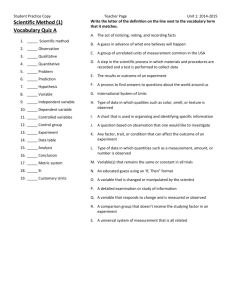Approach to Multiple Choice Questions
advertisement
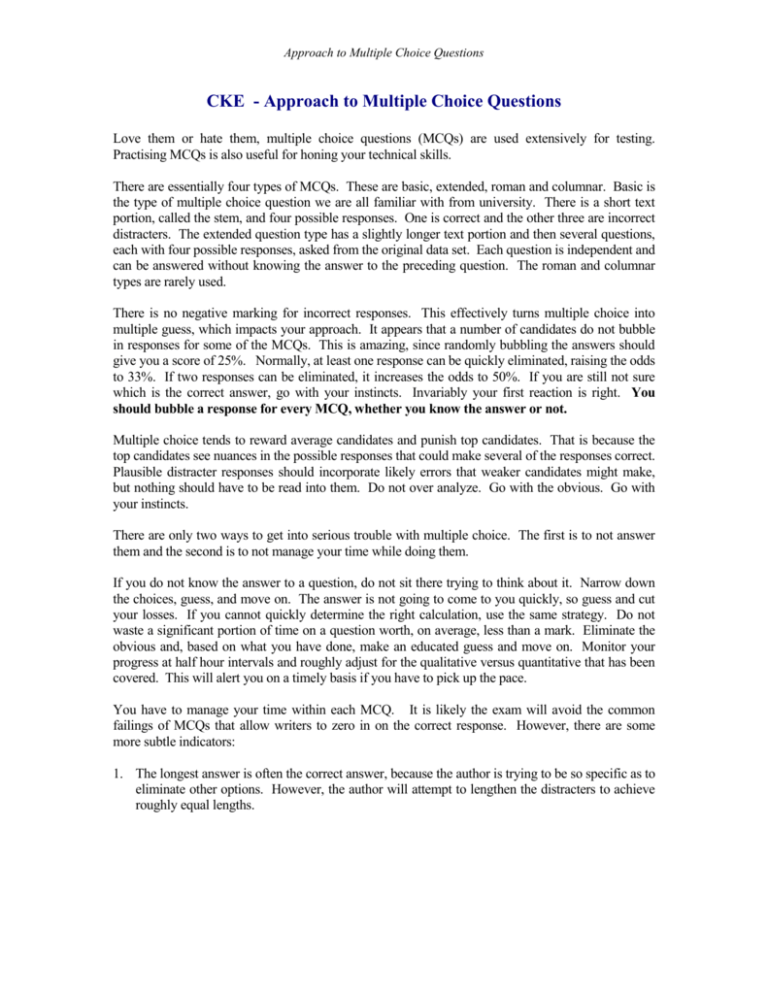
Approach to Multiple Choice Questions CKE - Approach to Multiple Choice Questions Love them or hate them, multiple choice questions (MCQs) are used extensively for testing. Practising MCQs is also useful for honing your technical skills. There are essentially four types of MCQs. These are basic, extended, roman and columnar. Basic is the type of multiple choice question we are all familiar with from university. There is a short text portion, called the stem, and four possible responses. One is correct and the other three are incorrect distracters. The extended question type has a slightly longer text portion and then several questions, each with four possible responses, asked from the original data set. Each question is independent and can be answered without knowing the answer to the preceding question. The roman and columnar types are rarely used. There is no negative marking for incorrect responses. This effectively turns multiple choice into multiple guess, which impacts your approach. It appears that a number of candidates do not bubble in responses for some of the MCQs. This is amazing, since randomly bubbling the answers should give you a score of 25%. Normally, at least one response can be quickly eliminated, raising the odds to 33%. If two responses can be eliminated, it increases the odds to 50%. If you are still not sure which is the correct answer, go with your instincts. Invariably your first reaction is right. You should bubble a response for every MCQ, whether you know the answer or not. Multiple choice tends to reward average candidates and punish top candidates. That is because the top candidates see nuances in the possible responses that could make several of the responses correct. Plausible distracter responses should incorporate likely errors that weaker candidates might make, but nothing should have to be read into them. Do not over analyze. Go with the obvious. Go with your instincts. There are only two ways to get into serious trouble with multiple choice. The first is to not answer them and the second is to not manage your time while doing them. If you do not know the answer to a question, do not sit there trying to think about it. Narrow down the choices, guess, and move on. The answer is not going to come to you quickly, so guess and cut your losses. If you cannot quickly determine the right calculation, use the same strategy. Do not waste a significant portion of time on a question worth, on average, less than a mark. Eliminate the obvious and, based on what you have done, make an educated guess and move on. Monitor your progress at half hour intervals and roughly adjust for the qualitative versus quantitative that has been covered. This will alert you on a timely basis if you have to pick up the pace. You have to manage your time within each MCQ. It is likely the exam will avoid the common failings of MCQs that allow writers to zero in on the correct response. However, there are some more subtle indicators: 1. The longest answer is often the correct answer, because the author is trying to be so specific as to eliminate other options. However, the author will attempt to lengthen the distracters to achieve roughly equal lengths. Approach to Multiple Choice Questions 2. Authors have a tendency to try and bury the correct number from a calculation by placing it as response b or c. Authors tend to shy away from option a as the correct response. Psychologically, it just does not feel right to give the right answer first. Hence, the mantra "when in doubt, the answer is c." 3. Humorous options can be quickly eliminated, which raises the odds of getting the correct response. That is why humour is generally restricted to company or individual names (e.g., Lossco, Mr. Disgruntled, etc.) to protect the integrity of the four responses. 4. Make sure you read the question carefully. Authors will change how the question is asked. Watch for the following items: correct vs. incorrect, true vs. false, most vs. least and not. 5. It is difficult for an author to derive three incorrect, but plausible, response options. If one option does not have an element that is included in the other three options, then it is usually a distracter and can be eliminated. 6. Accounting is not always an exact science. Accordingly, options with qualifiers such as "normally" or "generally" are more likely to be the correct response than an option with a definitive term such as "always" or "never". To help give you the idea, following is an example of a poorly-worded MCQ: 1. The key things about multiple choice testing are: a. b. c. d. Do not overreact when designing your technical knowledge study plan. Always bubble a response, as there is no negative marking penalty. Develop defensive writing skills based on the above discussions. All of the above The word “things” in the question stem denotes plural, which leads to response d. There cannot be a wrong answer if the correct answer is "all of the above". Technically, all four responses are correct. Note how there is a response length difference that highlights the correct response. Normally, the longest response has the greatest chance of being correct. However, in this question, the response length difference should allow you to focus on this response as one to either quickly eliminate or choose as the correct response. Once it is not quickly eliminated, it has a high probability of being the correct response.

